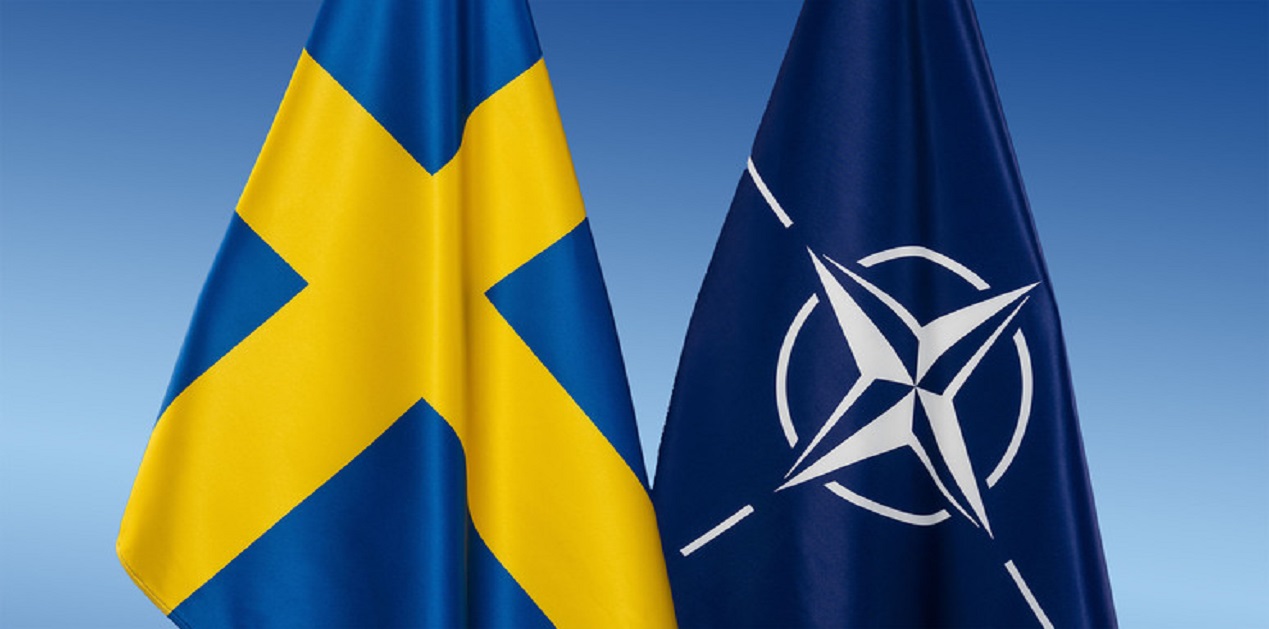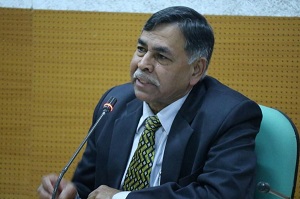On 7 March 2024, Sweden officially became NATO’s newest member, upon depositing its instrument of accession to the North Atlantic Treaty with the Government of the United States in Washington DC, thereby ending its 200-year-old policy of neutrality. When Swedish Prime Minister Ulf Kristersson deposited the final paperwork with US Secretary of State Antony Blinken, the last step needed for the former militarily nonaligned nation to become NATO’s 32nd member was completed.
Given the on-going war between Russia and Ukraine, Sweden’s accession marked a historic shift highlighting how Russian President Vladimir Putin’s war in Ukraine is transforming European security in ways he may not have foreseen. It would thus not be wrong to say that Sweden’s decision to join Europe’s security alliance system was spurred by the Ukraine war and geographic considerations. [1] Ironically, Putin had justified his aggression because he feared the possibility of NATO’s expansion. On the contrary, it was Putin who by his aggression was instrumental in bringing a stronger alliance on his doorstep. Russia willy-nilly now has to live with the consequences of its action in Ukraine for years. As Blinken remarked Ukraine became the clear example of the strategic debacle for Russia. He said: “Everything that Putin sought to prevent, he has actually precipitated by his actions, by his aggression”.
It may be recalled, Sweden embraced neutrality as a result of repeated conflicts with Russia—particularly the early nineteenth-century Finnish War, when it lost Finland to Russia. This time around, Russian aggression in Ukraine led to a dramatic reversal of that policy. This shall have major implications for the regional balance of power.
After the Great Northern War (1700-1721) [2], Sweden concluded that neutrality would best serve its sovereignty and national security. It avoided armed conflict, abstained from involvement in great-power spheres of influence, eschewed military alliances, and focussed on international peacekeeping and humanitarian initiatives. Even during the Cold War, its official policy was characterised as ‘non-alignment in peace, so as to maintain neutrality in war’, despite being economically, culturally, and militarily aligned with the United States.
Finland had already joined NATO in 2023. Now, with the addition of Sweden and Finland, NATO’s position in the far north shall be strengthened further. It is in this part that Russia maintains much of its second-strike nuclear capability aiming to boost its presence around the Baltic Sea, particularly around the Russia exclave of Kaliningrad. [3]
What advantages Sweden’s entry into the NATO brings to the existing alliance? Prior to joining, Sweden navy had operated in the Baltic waters and its fighter jets have patrolled the region’s skies. This positions Sweden capable of defending Baltic allies, if there is a need to do so. Sweden is already committed to send troops to join multinational force based in Latvia. For Sweden, there is reason to feel secure now than before. Sweden’s Prime Minister has also committed to comply with the alliance’s defence spending target of 2 per cent of gross domestic product from 2024 onwards.
Earlier, Sweden’s NATO bid was blocked at various points by Turkey, and then by Hungary. For Putin, the news of first Finland and now Sweden joining the Western security alliance system has come as a shock. When Finland joined NATO in 2023, Russia’s response was rather muted as it felt the need to adjust its military posture relating to NATO’s new borders and plans. A few years ago, it would have been inconceivable to even think that Sweden would join NATO as military nonalignment was part of its identity. But Russia’s military operation in Ukraine in February 2022 aroused Europe from a post-Cold War slumber and spurred the region’s relatively wealthy democracies to think about their own security.
As an immediate response to Russia’s aggression, the European Union suspended importing oil and gas from Russia and started sending weapons to Ukraine to fight against the Russian army. Defence spending also got renewed impetus. In fact, what is often overlooked is that global defence spending hit record $2.2 trillion amid multiple wars.
Subsequently, NATO drew up new battle plans to deter Russia and defend every inch of NATO territory should Moscow decide to become more adventurous. Soon, Sweden decided to participate in the Nordic Response military exercise involving 20,000 troops from 13 allied countries to express solidarity. Though Finland was quick in its response, Sweden took a little more time as its application for membership was awaiting clearance. Sweden’s dramatic rethink after initial reluctance was because it felt that if Russia was trying to erase one neighbour from the map, Putin might not stop there.
Though both Finland and Sweden initially expected a smooth accession process, the stringent laws binding NATO formation called for unanimity of the existing members to approve newcomers. It soon transpired that Turkey would object at every step. For more than 20 months, Turkey and then Hungary stalled the accession process of the two Baltic states. This public feuding pleased Putin. It soon became clear that Turkey’s main objection was for Sweden rather than Finland. Therefore, while Finland was able to join NATO in the spring of 2023, Sweden kept on negotiating, until all hurdles were cleared on 7 March 2024 when Sweden became NATO’s 32nd member.
Two related issues that delayed the accession of Finland and Sweden need mentioning. First, Turkish President Recep Tayyip Erdogan sought F-16 fighter jets from the US. Second, he insisted that Sweden cracks down on groups that Turkey considered to be terrorists. A third issue that may be added is that Hungarian Prime Minister Viktor Orban pressed Sweden’s Prime Minister to visit Budapest and cut a deal to get more Swedish-built fighter jets. In the end as it transpired, both Turkey and Hungary succeeded in extracting what they could before agreeing to welcome first Finland and then Sweden. Finally, both the new members came under Article 5 – collective defence clause – of NATO, huge shift for both. [4]
If one examines critically, one can see that Sweden’s co-called policy of neutrality was already diluted to some extent. Sweden’s position was something similar with that of India when India entered into a treaty of friendship and cooperation with the then USSR in 1971 in the wake of the Bangladesh liberation war that led many scholars to interpret that its long-held policy of non-alignment is already abandoned. Those critics overlooked the strategic compulsion that led then Indian government to seek support from its time-tested friend.
In Sweden’s case, there was no immediate compelling reason to seek membership of the NATO, though Russia’s Ukraine policy hastened the process. Sweden had already joined NATO’s Partnership for Peace programme in 1994 and started actively participating in NATO operations, EU-led rapid-response forces, and multinational defence activities. Sweden also provided specialised training for peacekeeping through its participation in various interoperability and readiness programmes.
So far, there was a broad trend towards defensive militarisation across Europe and within the European Union. Russia’s Ukraine war hastened the process as energy supplies were disrupted, sanctions imposed on Russia, threat perceptions increased and NATO members started focussing more on achieving strategic autonomy and on collective response. Both Finland and Sweden fitted well in the strategic narrative.
The fallout of the Ukraine war is that the EU has started focussing more on the defence industry. For example, the European Defence Industrial Strategy defined a roadmap for European arms manufacturers to increase investment and output, and encourage more collective procurement of European-made arms. Against this background, public opinion in Sweden had already swung in favour of NATO membership – 68 per cent favouring in 2023 as against 30 per cent in 2019. Only the Greens and the Communists had reservations.
What are the other possible factors that swayed public opinion in favour of becoming a member of the European security alliance? One overriding factor that cannot be overlooked is Sweden’s geographical proximity to Russia and that it is positioned within range of Russian air and naval power. When Russia increased its maritime presence, exercises, and manoeuvres in the Baltic Sea, Sweden felt a significant threat to its economy and sea lanes.
As Carla Norrlof remarks, “Russia’s anti-access/area-denial capabilities—including cruise missiles, surface-to-air missiles, and nuclear weapons based in Kaliningrad, along with its strategy of engaging in hybrid warfare below the threshold of armed conflict—continue to pose a serious threat across the Baltic region.” Such threats demanded a robust defence posture and heightened surveillance to deter aggression from any external source. This precipitated Sweden’s NATO membership outlook.
Full membership now would mean a lot for Sweden. Besides opening the door for cooperating significantly with NATO, Sweden will now be directly protected under Article 5 of the NATO Treaty as a full member. It shall have now greater access to cutting-edge military technology and deeper intelligence insights, all of which will help strengthen its defence capability against air, naval, submarine, and cyber threats. Sweden now can have a key role in shaping the alliance’s strategies, particularly in Northern Europe.
It is not only that Sweden’s interests now will be served. For NATO, Sweden’s accession shall allow the alliance to use Sweden’s strategic assets. This includes Gotland, a key hub for deploying reinforcements during any conflict, a strong defence industry that produces world-class military equipment such as advanced Gripen fighter jets and a modern, highly experienced submarines fleet. [5]
With all the Nordic countries – Denmark, Finland, Iceland, Norway and Sweden – now being aligned under the same security umbrella, the arrangement will now be complementary with each other. It is to be seen now if other neutral EU countries such as Austria and Ireland would take a lead from the example of the Nordic states and opt to join the larger security alliance. If that happens, it would mean a significant reconfiguration of security alliance across Europe.
The bigger question is: how does Russia view this new development? Surely, Russia views this as a sign of strategic encroachment, leading to more tensions. Russia is likely to respond with more military activities nearby and pursue more aggressive posturing. That would include frequent military exercises and deployments of advanced weaponry closer to NATO territories. The onus now lies on Sweden to convince Kremlin that its decision to join NATO is purely a precautionary measure. Whether this assurance shall calm Kremlin is unclear as it is likely continue viewing the expansion of NATO as a strategy to encircle it. The combined planning of the NATO, the US and the EU seems to be for the long-term isolation of Russia. Does this mean a return to the Cold War-style of containment strategy after years of co-existence and cooperation? If the Ukraine war does not end soon, such a scenario could be very much believable.
Prime Minister Narendra Modi has already spoken to the leaders of both Russia and Ukraine and urged both returning to peace. So far, such counsel has little effect. It may be desirable that Prime Minister Modi makes another effort and persuade both combatants to see the futility of conflict and benefits of peace.
References
[1] Emily Rauhala, “Sweden finally joins NATO in expansion spurred by Putin’s Ukraine war”, The Washington Post, 7 March 2024, https://www.washingtonpost.com/world/2024/03/07/sweden-joins-nato/
[2] The Great Northern War (1700 – 1721) was the main military conflict of Peter the Great's reign, ending in a Russian victory over Sweden that made Russia an important European power and expanded Russia's borders to the Baltic Sea, including the site of St. Petersburg.
[3] Emily Rauhala, “How Putin’s brutal war in Ukraine pushed Finland toward NATO”, The Washington Post, 30 April 2022, https://www.washingtonpost.com/world/2022/04/30/finland-join-nato/
[4] Carla Norrlof, “The meaning of Sweden’s NATO accession”, 25 March 2024, https://www.aspistrategist.org.au/the-meaning-of-swedens-nato-accession/?utm_medium=email&utm_campaign=Weekly%20The%20Strategist&utm_content=Weekly%20The%
[5] Ibid.
(The paper is the author’s individual scholastic articulation. The author certifies that the article/paper is original in content, unpublished and it has not been submitted for publication/web upload elsewhere, and that the facts and figures quoted are duly referenced, as needed, and are believed to be correct). (The paper does not necessarily represent the organisational stance... More >>
Image Source: https://www.nato.int/nato_static_fl2014/assets/pictures/images_mfu/2024/3/stock/240307-sweden-nato-flag_rdax_775x440s.jpg











Post new comment